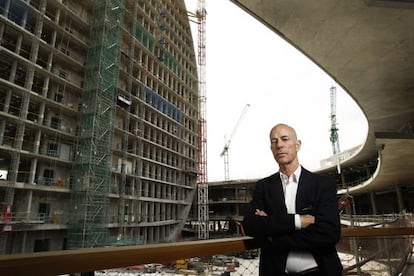“It is a building and also a small city”
Swiss Tate Modern architect Jacques Herzog is behind the BBVA bank’s iconic new Madrid HQ


Around 1,800 people are currently at work on the new headquarters of the BBVA bank, which are under construction in the northern Madrid suburb of Las Tablas. The building, which looks like a huge, one-third submerged coin, is set to be ready next year. The workforce takes breaks in the pavement cafés of the many bars and restaurants that line the surrounding avenues. One of the architects who helped design the building, Jacques Herzog, says the paradox sums up the building: iconic and urban at the same time, old and new together, hermetic from the outside, and full of light inside… “A major project cannot be homogenous,” he insists. The Swiss-born architect has learned Spanish, partly to improve communication while working on this project, and partly because he has just bought a house in the Canary Islands.
Herzog, who with his partner Pierre de Meuron, is also responsible for the capital’s CaixaForum cultural center and the TEA Museum in Tenerife, says he wants the people who work in his buildings to be in touch with their surroundings. Which is why he uses a great deal of wood for the interiors, as well as providing seating that allows occupants to take the time to look around them and appreciate his work. “It is more important to feel a building than to look at it. Architecture has changed a lot over the last five years. We don’t like eccentricity, but we also feel that there can be architecture in a wall, or in a staircase. That’s why it is an obligation to work with what one finds. In the Tate Modern in London, in the CaixaForum, or here, we had to trim back what was already there to give the project a new life. This headquarters is a building and also a small city,” he says.
How much more can we go on opening up architecture when the European elections have shown people want to shut themselves away further?”
A city for who? And what kind: walled, a ghetto? “Right now it looks like a fortress, but it could open up and function as a historic quarter of a city, with a pedestrian area and restaurants. That’s the thinking behind it,” he says.
That is the building’s biggest paradox: it address human dimensions within, but not to the outside world, says Herzog: “Buildings change. Diocletian’s Palace in Split, Croatia, is now part of the city’s center. In Basel, we created the headquarters of Novartis and Roche with the same conviction. These are large companies that need to protect themselves, but we designed them so that one day they could be part of a district within the city.”
That said, the presence of so many buildings conceived as closed spaces effectively creates an environment where fear is the ruling factor. Gated communities in city centers are a threat to the Mediterranean tradition of streets that are open to all, where shops, housing, and social life all take place. How to avoid this? “That is like asking where our society is headed. To what extent can we continue to open up architecture when the European elections have shown, with the exception of Spain, people want to shut themselves away yet further?” he asks. “Architecture has the potential to help revive street life, but it’s society that has to decide how we are going to live. All that we architects can do is not to destroy that potential. If you insist on creating hermetic buildings to make your mark, you are making a mistake. You have to leave enough space so that your work can integrate.”
The major works
Herzog & de Meuron are responsible for some of the most important buildings of the last three years:
Goetz Collection. Munich, 1992.
Ricola Factory. Mulhouse, 1993.
Dominus Winery. Napa Valley, 1997.
Tate Modern. London, 1999.
Prada Building. Tokyo, 2003.
Schaulager. Basel, 2003.
Allianz Arena. Munich, 2005.
CaixaForum. Madrid, 2005.
National Stadium. Beijing, 2007.
Lincoln Road Parking. Miami Beach, Florida, 2010.
Do you really think that a bank headquarters can become an open city? “It is a distinctive typology, a neighborhood to represent a bank. It doesn’t represent power and money. The first step has been taken,” he says, adding that he hates what he calls “ideological” architecture. “It has never worked. Power can be represented through monumental architecture to frighten people, but I am more interested in introducing intimacy into large areas.” This was his goal in the Tate Modern in 1999, which is now being extended. The Turbine room in the former power station is vast. “It works in London; in a small city it might frighten people,” he explains. “Architecture has to speak to the individual as well as the city.”
Herzog and his partner Meuron were awarded the Pritzker Prize in 2001 for their work on the Tate. They then decided they wanted to experiment with creating iconic buildings. After that they decided to move to a more stripped-down approach: “We are interested in real architecture, even hard architecture. It is the best way to attract people to enter a building.”
Where does Herzog believe an architect’s responsibilities lie? “In not wasting money, for one thing.” He says that it is not enough simply to meet contractual obligations: “A box for people to work in is pure cynicism, as are those monuments to architects’ vanity.” He says the future of architecture lies in defining buildings by the relation to the city around them: “We are Europeans, Swiss, and that idea of working in different languages is natural to us. Neither our culture or our architecture can send a single, closed, immovable message.”
Tu suscripción se está usando en otro dispositivo
¿Quieres añadir otro usuario a tu suscripción?
Si continúas leyendo en este dispositivo, no se podrá leer en el otro.
FlechaTu suscripción se está usando en otro dispositivo y solo puedes acceder a EL PAÍS desde un dispositivo a la vez.
Si quieres compartir tu cuenta, cambia tu suscripción a la modalidad Premium, así podrás añadir otro usuario. Cada uno accederá con su propia cuenta de email, lo que os permitirá personalizar vuestra experiencia en EL PAÍS.
¿Tienes una suscripción de empresa? Accede aquí para contratar más cuentas.
En el caso de no saber quién está usando tu cuenta, te recomendamos cambiar tu contraseña aquí.
Si decides continuar compartiendo tu cuenta, este mensaje se mostrará en tu dispositivo y en el de la otra persona que está usando tu cuenta de forma indefinida, afectando a tu experiencia de lectura. Puedes consultar aquí los términos y condiciones de la suscripción digital.
Últimas noticias
From Andorra to Gibraltar, a black market for Ozempic exploits its success: ‘They’re the most sought-after products in the world’
The brief rise and retreat of Generation Z in Mexico
From safe-haven investment to geostrategic weapon: Who owns the most gold and where are the bars kept?
Todd Green, head of the company that created ‘Candy Crush’: ‘Success for us is that players want to play for years’
Most viewed
- Why we lost the habit of sleeping in two segments and how that changed our sense of time
- Charles Dubouloz, mountaineering star, retires at 36 with a farewell tour inspired by Walter Bonatti
- Venezuela faces its most tense Christmas yet
- CBS in crisis after pulling a report on Trump’s deportations to El Salvador (which later leaked online)
- Bukele clan fumes over investigation exposing their new wealth








































